Optics
I felt an urge to have my own laser. I managed to get a 2 milliwatts Helium-Neon laser manufactured by NEC for
a bargain price and started experimenting with holograms and various types of deflection. Deflection was fun, because
it could be used to draw figures on the wall, or make funny lighting effects in general.
Rotating Deflection Unit
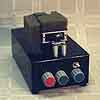
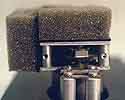 Using a minimum
of electronics and a heavily geared-down motor, I built this rotating mirror unit. It had four mirrors, mounted
on a gearwheel that could rotate in different speeds and run backwards and forwards for various periods of time.
The mirrors were actually mounted inside the gearbox, glued directly to the output gearwheel. Great for discotheques.
Using a minimum
of electronics and a heavily geared-down motor, I built this rotating mirror unit. It had four mirrors, mounted
on a gearwheel that could rotate in different speeds and run backwards and forwards for various periods of time.
The mirrors were actually mounted inside the gearbox, glued directly to the output gearwheel. Great for discotheques.
 This picture shows what it looked like in my laser lab in the basement,
experimenting with the rotating deflector. The light glow from the output hole of the laser is not an artefact
in the picture. HeNe lasers do emit in other wavelengths (blue), although not with the same power and directivity
as the red beam. The glow is not blue, because the gas storage tank of the laser tube emits a lot more in orange,
and I used daylight film, attenuating blue light.
This picture shows what it looked like in my laser lab in the basement,
experimenting with the rotating deflector. The light glow from the output hole of the laser is not an artefact
in the picture. HeNe lasers do emit in other wavelengths (blue), although not with the same power and directivity
as the red beam. The glow is not blue, because the gas storage tank of the laser tube emits a lot more in orange,
and I used daylight film, attenuating blue light.
X-Y Deflector for Laser
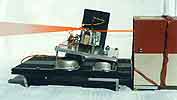 Everything culminated as I decided to build an X-Y
deflector, to be able to draw pictures on the wall with my laser. It took a large effort of fine mechanics and
magnet technology. I had to sit down at the drawing table and start calculating. The mechanics was built on a sturdy
aluminium plate, mounted on shock absorbers (the round metal cans), with set screws, to be able to be fine tuned
and directed properly.
Everything culminated as I decided to build an X-Y
deflector, to be able to draw pictures on the wall with my laser. It took a large effort of fine mechanics and
magnet technology. I had to sit down at the drawing table and start calculating. The mechanics was built on a sturdy
aluminium plate, mounted on shock absorbers (the round metal cans), with set screws, to be able to be fine tuned
and directed properly.
 Deflection had to be carried out by something small and lightweight,
preferably one hundredth of a gram, at the same time fast and taking a minimum of current. This miracle in miniature
was found in the form of a micro galvanometer manufactured by ABEM, Sweden. It is a tube, no more than 3 millimeters
in diameter, inside which, at a small opening is placed a turning mirror, possible to deflect with a very small
current. The galvanometers are lying on millimetre grid paper.
Deflection had to be carried out by something small and lightweight,
preferably one hundredth of a gram, at the same time fast and taking a minimum of current. This miracle in miniature
was found in the form of a micro galvanometer manufactured by ABEM, Sweden. It is a tube, no more than 3 millimeters
in diameter, inside which, at a small opening is placed a turning mirror, possible to deflect with a very small
current. The galvanometers are lying on millimetre grid paper.
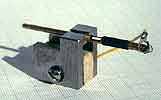 The galvanometer, in principle
being a moving coil instrument, needs an external magnetic field to be able to turn. I had to machine two, strangely
formed pole pieces out of soft iron and build a magnet system. I got the magnets from a mail-order company, and,
according to the technicians at ABEM, I managed to create higher magnetic field strength than they had in their
original application, the UV strip chart recorder.
The galvanometer, in principle
being a moving coil instrument, needs an external magnetic field to be able to turn. I had to machine two, strangely
formed pole pieces out of soft iron and build a magnet system. I got the magnets from a mail-order company, and,
according to the technicians at ABEM, I managed to create higher magnetic field strength than they had in their
original application, the UV strip chart recorder.
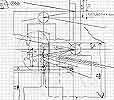
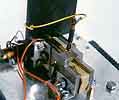 Deflection in X
and Y directions needs two mirror systems, mounted so close that the deflected beam from the first mirror, will
never wander outside the second. They have to sit at only a few millimetre's distance. Well, a few hours at the
drawing table solved this problem, too. The close-up shows the magnet systems with their galvanometers mounted.
Note the closeness of the galvanometers.
Deflection in X
and Y directions needs two mirror systems, mounted so close that the deflected beam from the first mirror, will
never wander outside the second. They have to sit at only a few millimetre's distance. Well, a few hours at the
drawing table solved this problem, too. The close-up shows the magnet systems with their galvanometers mounted.
Note the closeness of the galvanometers.
After lots of persuasion, I got a technician at ABEM to make special modifications to two 2 kHz micro galvanometers
(I needed bigger mirrors, a full 2x5 millimetres, and the UV lens had to go), and I could finish the deflector
unit, which functioned as intended.
Optical Burglar Alarm
Red Light Emitting Diodes had reached 2 candela at 50 mA and I realized that, in combination with a suitable
telescope, they could be used to send a beam of light around the house, to detect if someone tried to climb in
a window.
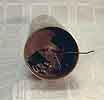 Two brass tubes were machined slightly, painted black
on the inside, and lenses bought from a mail-order company were mounted. The picture shows the receiving telescope
from the rear. In the middle you see the photo transistor, intended to view the pulsed, red beam. A little potentiometer
hangs underneath it, used for regulating idle current.
Two brass tubes were machined slightly, painted black
on the inside, and lenses bought from a mail-order company were mounted. The picture shows the receiving telescope
from the rear. In the middle you see the photo transistor, intended to view the pulsed, red beam. A little potentiometer
hangs underneath it, used for regulating idle current.
The idea was a good one, but at the same time microwave sensors started to appear on the market. They were much
simpler to mount than trying to put telescopes around the outside of the house.


 Using a minimum
of electronics and a heavily geared-down motor, I built this rotating mirror unit. It had four mirrors, mounted
on a gearwheel that could rotate in different speeds and run backwards and forwards for various periods of time.
The mirrors were actually mounted inside the gearbox, glued directly to the output gearwheel. Great for discotheques.
Using a minimum
of electronics and a heavily geared-down motor, I built this rotating mirror unit. It had four mirrors, mounted
on a gearwheel that could rotate in different speeds and run backwards and forwards for various periods of time.
The mirrors were actually mounted inside the gearbox, glued directly to the output gearwheel. Great for discotheques.






